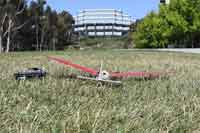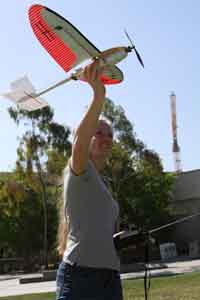Engineers look to birds for future unmanned aerial vehicles
By By Andrea Siedsma | 28 May 2011
UC San Diego engineers are hoping their research will aid to the future of UAVs, which are quickly becoming popular tools for the armed forces, and a myriad of civilian applications, such as wildfire monitoring, search and rescue, and traffic observation.
 |
| UC San Diego engineers are hoping their research will aid to the future of UAVs, which are quickly becoming popular tools for the armed forces, and a myriad of civilian applications, such as wildfire monitoring, search and rescue, and traffic observation. |
Engineers at UC San Diego are mimicking the movement of bird wings to help improve the maneuvrability of unmanned aerial vehicles (UAVs).
UAVs are often used for surveillance of a fixed target in military and civilian applications. In order to observe a stationary target, a fixed wing UAV must remain airborne over the object, thus expending energy for propulsion and reducing operational time. In addition, the aircraft may need to loiter at significant altitudes to avoid detection, and thus require complex sensors to observe the target far below. Rotary wing aircraft may be able to land on a perch for surveillance, but are generally less efficient for cruising flight than a fixed wing solution. A fixed wing aircraft capable of spot landing on a perch (top of a pole, building, fence, etc.) would be an ideal solution capable of efficient cruising and versatile landing for longer surveillance missions. Because the target is nearby, simple sensors could be used onboard the perched aircraft.
The problem of perching has already been solved by nature. Birds routinely land on small surfaces, using wing morphing and flapping techniques. The UC San Diego engineers, led by mechanical and aerospace engineering professor Tom Bewley and graduate student Kim Wright, analyzed in slow motion several videos of birds landing to generate a working hypotheses for how wing morphing and flapping can be used for spot landing.
 |
| UC San Diego aerospace and mechanical engineering graduate student Kim Wright studied the flight and movement of various types of birds to design a prototype UAV. |
To verify their hypotheses, Wright and her team built a small remote controlled UAV with variable wing sweep and tested it using computer modeling, and an onboard microcontroller as a flight data recorder. Their initial testing validated the concept of using wing sweep for pitch control of the aircraft.
Kim wright
UC San Diego aerospace and mechanical engineering graduate student Kim Wright studied the flight and movement of various types of birds to design a prototype UAV.
The biologically-inspired aircraft design is similar in scale to the birds the engineers observed (barn owl, hawks, large parrots, crows) and has similar wing loading and airfoil characteristics. The fuselage and tail surfaces of the prototype UAV were primarily constructed from balsa wood and foam using standard hobby aircraft construction techniques. The wings were formed using composite construction utilizing carbon fiber, fiberglass, high density foam, and rip stop nylon. Carbon fiber tubing was used for the shoulder joint structure, and fiberglass reinforcement was used in heavily stressed areas on the fuselage.
Future research could address combining wing twist, flapping, or other wing morphing aspects of the perching problem that UAVs currently have. Being able to perch UAVs autonomously on features in the environment (tree tops, buildings, telephone poles, etc...), and then to take off again as required, is an immensely valuable and significantly increases mission duration.






























